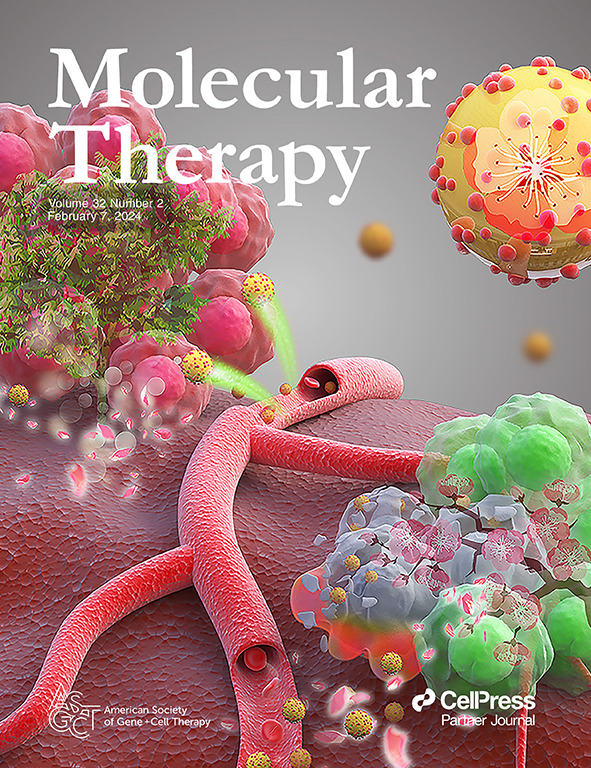AAV-miRNA治疗性抑制AASS可挽救小鼠戊二酸尿I型严重表型。
IF 12.1
1区 医学
Q1 BIOTECHNOLOGY & APPLIED MICROBIOLOGY
引用次数: 0
摘要
戊二酸尿症I型(Glutaric aciduria type I, GA1)是一种遗传性疾病,由谷氨二酰辅酶a脱氢酶在赖氨酸降解途径中酶缺陷引起,以中枢神经系统毒性代谢物积累为特征。我们认为,针对赖氨酸分解代谢的第一酶- α -氨基己二半醛合酶(AASS)的底物还原治疗可能是一种有吸引力的治疗选择。我们探索通过人工microRNA将AASS靶序列嵌入miR-16骨干(miR_AASS)来降低AASS的表达。我们分析了几种递送途径和AAV血清型,并在GA1的Gcdh-/-小鼠模型中评估了新生儿系统递送AAV9_miR_AASS的治疗效果。我们检测了GA1中主要受影响的组织肝脏和纹状体中miR-AASS的剂量依赖性表达和AASS抑制。在赖氨酸过载小鼠中,AAV9_miR_AASS治疗可减少纹状体中神经毒性代谢物的积累,治疗后长达6个月,防止神经病理改变,提高小鼠存活率。我们的研究结果表明,AAV9_miR_AASS支持降低aass作为GA1的潜在基因治疗策略。本文章由计算机程序翻译,如有差异,请以英文原文为准。
Therapeutic AASS inhibition by AAV-miRNA rescues glutaric aciduria type I severe phenotype in mice.
Glutaric aciduria type I (GA1) is an inherited disorder caused by the enzymatic defect of glutaryl-CoA dehydrogenase in the lysine degradation pathway, characterized by the accumulation of toxic metabolites in the central nervous system. We reasoned that substrate reduction therapy targeting the alpha-Aminoadipic Semialdehyde Synthase (AASS), the first enzyme in the catabolism of lysine, could provide an attractive therapeutic alternative. We explored to reduce the expression of AASS by an artificial microRNA with AASS target sequences embedded in a miR-16 backbone (miR_AASS). We analyzed several delivery routes and AAV serotypes and evaluated the therapeutic efficacy of a systemic neonatal delivery of AAV9_miR_AASS in the Gcdh-/- mouse model of GA1. We detected dose-dependent miR-AASS expression and AASS inhibition in liver and striatum, the main tissues affected in GA1. Treatment with AAV9_miR_AASS in lysine overload challenged mice reduced the accumulation of neurotoxic metabolites, up to six months post-treatment in the striatum, prevented the neuropathological alterations and improved mouse survival. Our results show that AAV9_miR_AASS supports AASS-lowering as a potential gene therapy strategy for GA1.
求助全文
通过发布文献求助,成功后即可免费获取论文全文。
去求助
来源期刊

Molecular Therapy
医学-生物工程与应用微生物
CiteScore
19.20
自引率
3.20%
发文量
357
审稿时长
3 months
期刊介绍:
Molecular Therapy is the leading journal for research in gene transfer, vector development, stem cell manipulation, and therapeutic interventions. It covers a broad spectrum of topics including genetic and acquired disease correction, vaccine development, pre-clinical validation, safety/efficacy studies, and clinical trials. With a focus on advancing genetics, medicine, and biotechnology, Molecular Therapy publishes peer-reviewed research, reviews, and commentaries to showcase the latest advancements in the field. With an impressive impact factor of 12.4 in 2022, it continues to attract top-tier contributions.
 求助内容:
求助内容: 应助结果提醒方式:
应助结果提醒方式:


